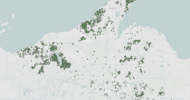By Lester R. Brown
Some 3,000 years ago, farmers in eastern China domesticated the soybean. In 1765, the first soybeans arrived in North America, but they did not soon catch on as a crop. For 150 years or so the soybean languished as a curiosity in gardens.
Then in the late 1920s, a market for soybean oil began to develop, moving the soybean from the garden to the field. During the 1930s, soybean production in the United States climbed from 400,000 tons to over 2 million tons. And as growth in the demand for the oil gained momentum, soybean production jumped to over 8 million tons in 1950.
During the 1940s and early 1950s, the soybean crop was harvested and crushed primarily for the 20 percent of the bean that was oil. Then during the 1950s, the demand for meat, milk, and eggs climbed. With little new grassland to support expanding beef and dairy herds, farmers started feeding their animals more grain supplemented with soybean meal in order to produce more beef and milk. Farmers were already relying heavily on grain to produce pork, poultry, and eggs. By 1960 soybean meal had become the primary product of soybean crushing and oil the secondary one. For the first time, the value of the meal exceeded that of the oil, an early sign of things to come in the changing role of the soybean.
This rise in the demand for soybean meal reflected the discovery by animal nutritionists that combining 1 part soybean meal with 4 parts grain, usually corn, in feed rations would sharply boost the efficiency with which livestock and poultry converted grain into animal protein. This was the soybean’s ticket to agricultural prominence, enabling it to join wheat, rice, and corn as one of the world’s four leading crops.
The main soybean producers today, in round numbers, are the United States at 80 million tons, Brazil at 70 million tons, and Argentina at 45 million tons. Together they account for over four fifths of world soybean production. China is a distant fourth at a mere 14 million tons. For six decades, the United States was both the leading producer and exporter of soybeans, but in 2011 Brazil’s exports narrowly eclipsed those from the United States.
To most consumers, the soybean is an invisible food, one that is embodied in many of the products found in any refrigerator. Clearly, the soybean is far more pervasive in the human diet than the visual evidence would indicate.
The world demand for soybeans is increasing by some 7 million tons per year. It is being driven primarily by the 3 billion people who are moving up the food chain, consuming more grain- and soybean-intensive livestock products. Population growth is also driving up the demand for soybeans, either indirectly through the consumption of livestock products or directly through the consumption of tofu, miso, and tempeh. In the two leading consumers of soybeans, the United States and China, populations are growing by 3 million and 6 million per year, respectively. And finally, an increasing demand for soy oil for biodiesel is also ramping up soybean use.
The principal effect of soaring world soybean consumption has been a restructuring of agriculture in the western hemisphere. In the United States there is now more land in soybeans than in wheat. In Brazil, the area in soybeans exceeds that of all grains combined. Argentina’s soybean area is now close to double that of all grains combined, putting the country dangerously close to becoming a soybean monoculture.
Satisfying the climbing global demand for soybeans poses a huge challenge. Since the soybean is a legume, fixing atmospheric nitrogen in the soil, it is not as fertilizer-responsive as, say, corn, which has a ravenous appetite for nitrogen. And because the soy plant uses a portion of its metabolic energy to fix nitrogen, it has less energy to produce seed. This makes raising yields difficult.
Unfortunately, if world soybean consumption continues to climb at a rapid rate, the economic pressures to clear more land could become intense. And if the additional land to meet the expanding demand is not in Brazil, where will it be? Where will the new land for soybeans come from?
For the full report click here.
From Full Planet, Empty Plates: The New Geopolitics of Food Scarcity by Lester R. Brown (New York: W.W. Norton & Co.). Supporting data, video, and slideshows are available for free download at www.earth-policy.org/books/fpep.
Some 3,000 years ago, farmers in eastern China domesticated the soybean. In 1765, the first soybeans arrived in North America, but they did not soon catch on as a crop. For 150 years or so the soybean languished as a curiosity in gardens.
Then in the late 1920s, a market for soybean oil began to develop, moving the soybean from the garden to the field. During the 1930s, soybean production in the United States climbed from 400,000 tons to over 2 million tons. And as growth in the demand for the oil gained momentum, soybean production jumped to over 8 million tons in 1950.
During the 1940s and early 1950s, the soybean crop was harvested and crushed primarily for the 20 percent of the bean that was oil. Then during the 1950s, the demand for meat, milk, and eggs climbed. With little new grassland to support expanding beef and dairy herds, farmers started feeding their animals more grain supplemented with soybean meal in order to produce more beef and milk. Farmers were already relying heavily on grain to produce pork, poultry, and eggs. By 1960 soybean meal had become the primary product of soybean crushing and oil the secondary one. For the first time, the value of the meal exceeded that of the oil, an early sign of things to come in the changing role of the soybean.
This rise in the demand for soybean meal reflected the discovery by animal nutritionists that combining 1 part soybean meal with 4 parts grain, usually corn, in feed rations would sharply boost the efficiency with which livestock and poultry converted grain into animal protein. This was the soybean’s ticket to agricultural prominence, enabling it to join wheat, rice, and corn as one of the world’s four leading crops.
The main soybean producers today, in round numbers, are the United States at 80 million tons, Brazil at 70 million tons, and Argentina at 45 million tons. Together they account for over four fifths of world soybean production. China is a distant fourth at a mere 14 million tons. For six decades, the United States was both the leading producer and exporter of soybeans, but in 2011 Brazil’s exports narrowly eclipsed those from the United States.
To most consumers, the soybean is an invisible food, one that is embodied in many of the products found in any refrigerator. Clearly, the soybean is far more pervasive in the human diet than the visual evidence would indicate.
The world demand for soybeans is increasing by some 7 million tons per year. It is being driven primarily by the 3 billion people who are moving up the food chain, consuming more grain- and soybean-intensive livestock products. Population growth is also driving up the demand for soybeans, either indirectly through the consumption of livestock products or directly through the consumption of tofu, miso, and tempeh. In the two leading consumers of soybeans, the United States and China, populations are growing by 3 million and 6 million per year, respectively. And finally, an increasing demand for soy oil for biodiesel is also ramping up soybean use.
The principal effect of soaring world soybean consumption has been a restructuring of agriculture in the western hemisphere. In the United States there is now more land in soybeans than in wheat. In Brazil, the area in soybeans exceeds that of all grains combined. Argentina’s soybean area is now close to double that of all grains combined, putting the country dangerously close to becoming a soybean monoculture.
Satisfying the climbing global demand for soybeans poses a huge challenge. Since the soybean is a legume, fixing atmospheric nitrogen in the soil, it is not as fertilizer-responsive as, say, corn, which has a ravenous appetite for nitrogen. And because the soy plant uses a portion of its metabolic energy to fix nitrogen, it has less energy to produce seed. This makes raising yields difficult.
Unfortunately, if world soybean consumption continues to climb at a rapid rate, the economic pressures to clear more land could become intense. And if the additional land to meet the expanding demand is not in Brazil, where will it be? Where will the new land for soybeans come from?
For the full report click here.
From Full Planet, Empty Plates: The New Geopolitics of Food Scarcity by Lester R. Brown (New York: W.W. Norton & Co.). Supporting data, video, and slideshows are available for free download at www.earth-policy.org/books/fpep.













